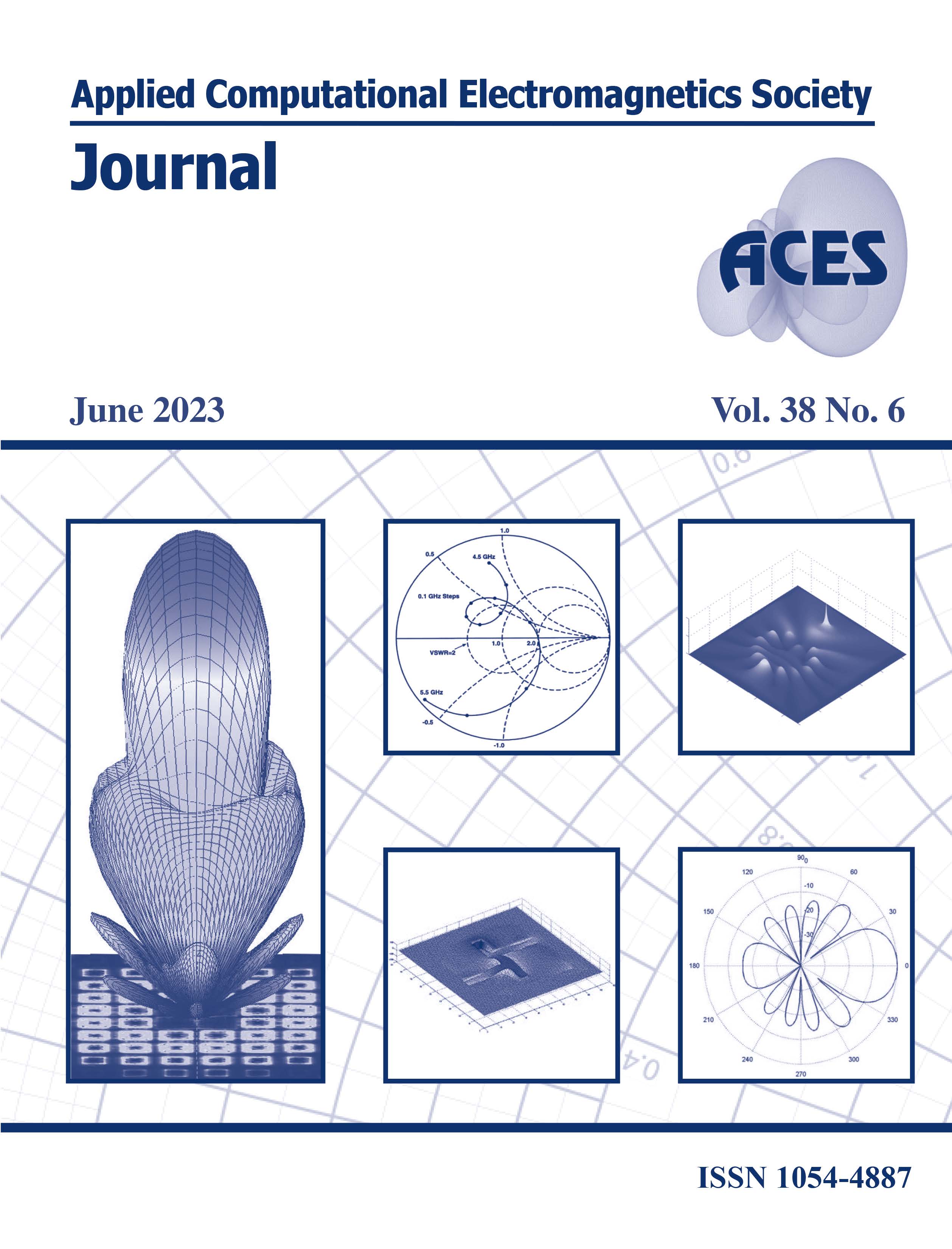Unified Formulation for Evaluation and Visualization of Electric and Magnetic Fields Inside Waveguides and Cavities
DOI:
https://doi.org/10.13052/2023.ACES.J.380609Keywords:
Cavity Resonators, Educational Software, EM Fields, WaveguidesAbstract
The output of this research is an interactive software package developed to enhance and expedite the design of waveguides and cavity resonators through the computation and visualization of the electric and magnetic field distribution. The software features a user-friendly interface through which users can select one of seven different configurations and specify parameters of their design, such as structure dimensions, transverse electric or magnetic mode, mode numbers, operating frequency, number of points of any of the field components along the x, y, and z axis for rectangular structures, and any 2D plane angles between 0∘ to 360∘ for cylindrical structures. Both transverse and longitudinal field components can be visualized in vector, color contour or both. The software makes it easy for users to see how the changes of physical dimensions and operating frequency affect the field distribution. Moreover, the user interface allows users to select how visualizations of the field distribution are generated and displayed. Field distributions can be displayed as static images or video animations using appropriate sequencing of computed field values at different plane cuts. The software provides all necessary warning messages for invalid input parameters. Mathematical expressions of the field components used in this software were derived from the classical solution of the wave equations using the separation of variables technique in cartesian coordinates for rectangular configurations and cylindrical coordinates for all other configurations. Results obtained using this software were validated against values found in the literature for similar types of problems, and results show perfect agreement.
Downloads
References
K. S. Packard, “The origin of waveguides: A case of multiple rediscovery,” IEEE Transactions on Microwave Theory and Techniques, vol. 32, no. 9, pp. 961-969, 1984.
N. N. Rao, “PC-assisted instruction of introductory electromagnetics,” IEEE Transactions on Education, vol. 33, no. 1, pp. 51-59, 1990.
S. Farjana, M. Ghaderi, A. U. Zaman, S. Rahiminejad, P. Lundgren, and P. Enoksson, “Low-loss gap waveguide transmission line and transitions at 220–320 GHz using dry film micromachining,” IEEE Transactions on Components, Packaging and Manufacturing Technology, vol. 11, no. 11, pp. 2012-2021, 2021.
REMCOM, “How to build a rectangular waveguide in XFDTD,” Remcom Inc State College, PA, [Online].
Y. Zhao, Y. Li, B. Pan, S. H. Kim, Z. Liu, M. M. Tentzeris, J. Papapolymerou, and M. G. Allen, “RF evanescent-mode cavity resonator for passive wireless sensor applications,” Sensors and Actuators A: Physical, vol. 161, no. 1-2, pp. 322-328,2010.
A. Sahu, V. K. Devabhaktuni, R. K. Mishra, and P. H. Aaen, “Recent advances in theory and applications of substrate-integrated waveguides: a review,” International Journal of RF and Microwave Computer-Aided Engineering, vol. 26, no. 2, pp. 129-145, 2016.
A. Z. Elsherbeni and C. D. Taylor, “Interactive visualizations of electromagnetic fields inside waveguides and cavity resonators using the WGC program,” Computer Applications in Engineering Education, vol. 2, no. 2, pp. 97-107,1994.
F. D. Mbairi and H. Hesselbom, “High frequency design and characterization of SU-8 based conductor backed coplanar waveguide transmission lines,” in Proceedings. International Symposium on Advanced Packaging Materials: Processes, Properties and Interfaces, 2005, pp. 243-248,2005.
I. Jeong, S. H. Shin, J. H. Go, J. S. Lee, C. M. Nam, D. W. Kim, and Y. S. Kwon, “High-performance air-gap transmission lines and inductors for millimeter-wave applications,” IEEE Transactions on Microwave Theory and Techniques, vol. 50, no. 12, pp. 2850-2855, 2002.
F. Taringou, D. Dousset, J. Bornemann, and K. Wu, “Substrate-integrated waveguide transitions to planar transmission-line technologies,” in 2012 IEEE/MTT-S International Microwave Symposium Digest, pp. 1-3, 2012.
J. Shi, H. Chen, S. Zheng, D. Li, R. Rimmer, and H. Wang, “Comparison of measured and calculated coupling between a waveguide and an RF cavity using CST microwave studio,” Thomas Jefferson National Accelerator Facility, Newport News, VA, technical report, 2006.
E. Pucci, A. U. Zaman, E. Rajo-Iglesias, P.-S. Kildal, and A. Kishk, “Losses in ridge gap waveguide compared with rectangular waveguides and microstrip transmission lines,” in Proceedings of the Fourth European Conference on Antennas and Propagation, pp. 1-4,2010.
N. A. Amoli, S. Sivapurapu, R. Chen, Y. Zhou, M. L. Bellaredj, P. A. Kohl, S. K. Sitaraman, and M. Swaminathan, “Screen-printed flexible coplanar waveguide transmission lines: Multi-physics modeling and measurement,” in 2019 IEEE 69th Electronic Components and Technology Conference (ECTC), pp. 249-257,2019.
S. H. Kamath, R. Arora, and V. Agarwal, “Studying the characteristics of a rectangular waveguide using HFSS,” International Journal of Computer Applications, vol. 118, no. 21, pp. 5-8,2015.
Y. Zhou, H. Liu, E. Li, G. Guo, and T. Yang, “Design of a wideband transition from double-ridge waveguide to microstrip line,” International Conference on Microwave and Millimeter Wave Technology, pp. 737-740, 2010.
Zeland Software Inc., Fremont, CA, “Software for optimizing the design and low-cost production of waveguide filters,” Microwave Journal, [Accessed: March 24, 2022]: https://www.microwavejournal.com, 2002.
M. Al Ameen, J. Liu, and K. Kwak, “Security and privacy issues in wireless sensor networks for healthcare applications,” Journal of medical systems, vol. 36, no. 1, pp. 93-101,2012.
S. Mitheran, R. T. Narayanan, and R. Singaravelu, “User-friendly waveguide mode visualizer, Educator’s corner,” IEEE Microwave Magazine, vol. 23, no. 5, pp. 96-100, 2022.
A. Z. Elsherbeni and C. D. Taylor, Jr., “Electromagnetic Fields Inside Waveguides and cavity resonators; WGC (version 2.1),” Software Book II, Center on Computer Applications for Electromagnetic Education (CAEME), 1994.
MathWorks, “App designer-create desktop and web apps in MATLAB,” Mathworks Natick, MA, https://www.mathworks.com [Accessed: August 01, 2021].
C. A. Balanis, Advanced Engineering Electromagnetics. John Wiley & Sons, 2012.
A. Elsherbeni, D. Kajfez, and S. Zeng, “Circular sectoral waveguides,” IEEE Antennas and Propagation Magazine, vol. 33, no. 6, pp. 20-27,1991.




